David McFall R.A. (1919 - 1988)
Sculptor
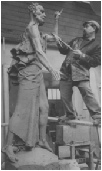
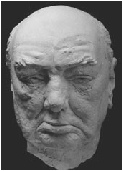
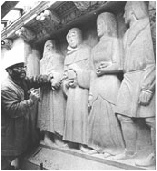
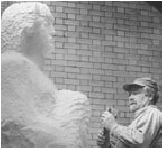

1976/6 Memorial to Ian Fraser
Baron Fraser of Lonsdale CH, CBE (1897 – 1974) Chairman of St. Dunstan's
Inscribed plaque of Brathay Blue Corniston Slate,
with bronze profile portrait and Coat of Arms with motto
"Je Suis Prest"
Sited in West Cloister Walk, Crypt in Westminster Abbey and unveiled on 14/10/1976. It was
the first memorial in Westminster Abbey for 900 years to have a braille inscription
Reference: The Guardian 15/10/76 p.6. McFall was recommended for this commission by J. Peter Foster MA, FSA, ARIBA, Surveyor of the Fabric of Westminster Abbey. A further cast of the relief profile is in South Africa on oak mount
Unveiling in Westminster Abbey 14/10/1976
William Jocelyn Ian Fraser, Baron Fraser of Lonsdale CH CBE, (30 August 1897 – 19 December 1974), known as Ian Fraser, was Chairman of St Dunstans, a charity for blind serviceman, Governor of the BBC, businessman and a British politician in the Conservative Party.
Fraser was th e son of William Percy Fraser a businessman of South Africa, who played
a role in the development of Johannesburg. He was born in England but spent his early
years in South Africa. He returned to England and was educated at St Cyprian's School
Eastbourne and Marlborough College. He went to Sandhurst at the start of World War
I and in the spring of 1916, he was sent out to join the army in France where he
was a Captain in the King's Shropshire Light Infantry. At the Battle of the Somme
on 23 July 1916, a German bullet blinded him. He was sent back to England to the
Officers Ward of the London General Hospital and when the bandages were finally removed
it was found that he had lost the sight of both eyes. Sir Arthur Pearson, the Chairman
of St Dunstan's, the independent charity for blind servicemen and women, wrote him
a letter explaining how he had gone blind in middle life and how he had made the
best of it. He told how he had established St Dunstans to train war-blinded men and
invited him to go there. The letter was delivered to him by Irene "Chips" Mace whom
he later married. He accepted the invitation and when Sir Arthur died after an accident
in his bathroom, Fraser, aged twenty-four, was chosen to succeed him as Chairman,
a position he held for 52 years. He wrote his autobiography "Whereas I was Blind"
at the beginning of World War II as encouragement in anticipation of soldiers being
blinded once again.
e son of William Percy Fraser a businessman of South Africa, who played
a role in the development of Johannesburg. He was born in England but spent his early
years in South Africa. He returned to England and was educated at St Cyprian's School
Eastbourne and Marlborough College. He went to Sandhurst at the start of World War
I and in the spring of 1916, he was sent out to join the army in France where he
was a Captain in the King's Shropshire Light Infantry. At the Battle of the Somme
on 23 July 1916, a German bullet blinded him. He was sent back to England to the
Officers Ward of the London General Hospital and when the bandages were finally removed
it was found that he had lost the sight of both eyes. Sir Arthur Pearson, the Chairman
of St Dunstan's, the independent charity for blind servicemen and women, wrote him
a letter explaining how he had gone blind in middle life and how he had made the
best of it. He told how he had established St Dunstans to train war-blinded men and
invited him to go there. The letter was delivered to him by Irene "Chips" Mace whom
he later married. He accepted the invitation and when Sir Arthur died after an accident
in his bathroom, Fraser, aged twenty-four, was chosen to succeed him as Chairman,
a position he held for 52 years. He wrote his autobiography "Whereas I was Blind"
at the beginning of World War II as encouragement in anticipation of soldiers being
blinded once again.
Fraser became MP for St. Pancras North by a narrow majority at the 1924 general election. After losing the seat in the 1929 general election, he regained it in 1931. In 1934, he received a knighthood in recognition of the effort that he had put into developing St Dunstans, and two years later he was appointed a Governor of the BBC. Being on the committee of the BBC, he was no longer allowed to remain a Member of Parliament and resigned his seat. However, in April 1940, the Prime Minister Winston Churchill introduced an Act of Parliament, which allowed certain people to be members of parliament and to hold office in the BBC in the public interest during the war. Fraser was elected for Lonsdale in 1940, and held the seat until 1958.
Fraser also held many positions on the Boards of other companies. From 1936, he had been on the Advisory Council of the company Frasers Limited, which had been set up by two uncles trading in Southern Africa. This advisory council was made up of members of the Frasers family, living in England, to whom the Board of Frasers had to report from time to time. He was elected to the Board of Frasers Ltd in 1954 and became Chairman after the sudden death of Douglas Fraser in 1956. He would spend two to three months every year at Fraser House in Wepener
Fraser was appointed a Companion of Honour in 1953 and in 1958 became the first life peer created under the Life Peerages Act 1958 which had been introduced by Harold Macmillan. He took the title of Baron Fraser of Lonsdale, of Regent's Park in the County of London on 1 August 1958.
Lord Redcliffe-Maud said at the service of Thanksgiving held in Westminster Abbey on Tuesday 4 February 1975: "I will lift up mine eyes unto the hills. Therefore, indeed we would if we have eyes to lift. However, the achievement of Ian Fraser's life can be summed up like this; he lifted up the loss of his eyes, in bounden duty and service, day by day for nearly 60 years of his 77 years of life. That living sacrifice was accepted and made creative of great good. It has put new heart into tens of thousands of the sightless (and the sighted) that came within its influence, and nothing will stop the good work now. It would never be the same as if Lord Fraser had not lived and learnt the mystery of the road of Suffering".
Lord Fraser married Irene Mace (or "Chips" as he called her) the girl who had delivered Pearson's letter and who he said at the time wore the smoothest and most beautiful kid gloves that he had ever felt. He dedicated the book he wrote in 1961 to her saying that she had more influence over the affairs of St Dunstans that any other women possibly than any other person.
All rights reserved
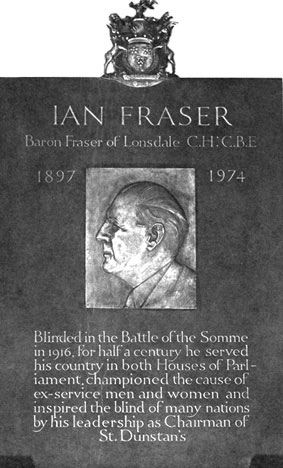


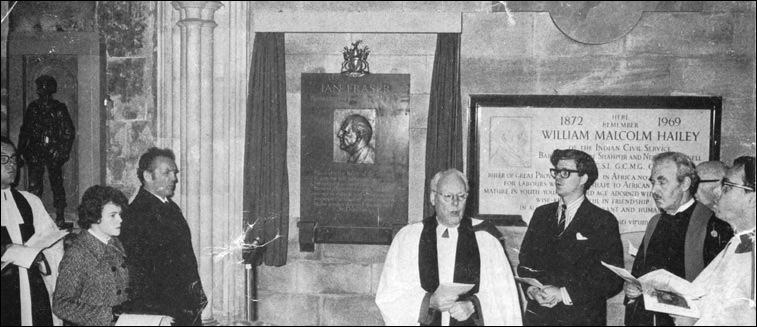
| Animals |
| Busts and Heads |
| Children |
| Churchill studies |
| Lettering |
| Medals coins plates |
| Reliefs |
| Stone carvings |
| Contemporary British Artists |
| On Epstein |
| Picasso |
| The art of portrait sculpture |
| Letters |
| Palliser |
| Son of Man |
| Press |
| Obituaries |
| Memorial address |